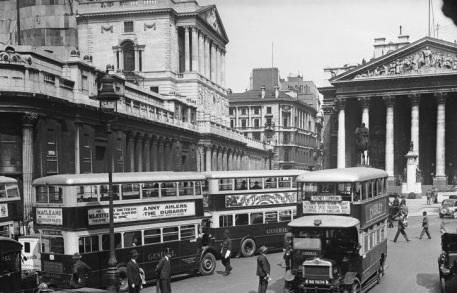
London Belongs to Me is an enormous doorstopper of a book that looks rather overwhelming when you first pick it up, with its almost transparently thin pages, tiny text and a vast array of characters who you initially feel you might need a family tree to keep track of. But, as soon as you’ve read the first chapter and are immersed in the colourful, lively, hilarious and often touching world of the inhabitants of 10 Dulcimer Street, any trepidation falls away, and you become lost within the streets of prewar London.
10 Dulcimer Street is owned by middle aged, straight-laced widow Mrs Vizzard, who, anxious not to touch her capital, has let out the various floors of her Georgian terrace to fellow Londoners in order to make ends meet. Ever conscious of frugality, she herself lives in the basement, where she focuses her interests on spiritualism, leaving the best part of the upper floors to be rented by the Jossers, a couple in their sixties.Mr Josser has just retired, and is looking forward to using his life savings to buy a country cottage for he and his wife to live in, away from the smog of London. But now it’s come to it, Mrs Josser isn’t quite sure she wants to leave London, especially as their daughter, Doris, has decided to get a flat with her hoity-toity friend Doreen from the office, and thinks she’s too good to stop at home with her parents. Much family distress ensues. Upstairs lives quiet, devoted Mrs Boon, also a widow, who lives for her son Percy. Percy is quite the young man on the up, making a name for himself as a successful mechanic, with dreams of owning his own garage one day. But the thing is, making enough money to buy the smart house and top notch car Percy desires will take time, and Percy isn’t sure he wants to wait. He’s got his eye on Doris Josser, and when a friend offers him the opportunity to dabble in a little bit of car thievery on the side to make a tidy sum very quickly, Percy jumps at the chance. Getting up to no good comes naturally to washed up, elderly actress Connie, who lives above the Boons with only her canary for company. Her face perpetually made up in a doll-like mask, she forces her way into the lives of the inhabitants of Dulcimer Street, never one to miss the opportunity for a gossip, or a free meal, living hand to mouth as she does since the boards have given her up. Facing her own destitution, Connie could be forgiven for her fits of tears and melancholy as she lies in her lonely bed, but she always manages to find a reason to carry on, especially when it involves sticking her nose in where it’s not wanted. Above Connie is Mr Puddy, a lazy middle aged widower, who lives for his food and a quiet life. He tries not to get involved in the lives of the others, and instead focuses his energies on making sure he can get the most for himself by doing the least work possible.It’s no surprise that he’s forever at the employment agency after a fall-out with a boss who had the cheek to ask him to do more work than he ought by rights be asked to do.
However, life begins to change for the inhabitants of Dulcimer Street as Doris moves out, a mysterious Mr Squales moves into the spare room in Mrs Vizzard’s basement, Percy’s criminal doings catch up with him, and the war starts to become an ever likelier possibility. Though they are all separate family units with entirely separate lives, their changing circumstances begin to demonstrate that the bonds between the residents are stronger than they may have realised.When tragedy strikes, the house must come together to fight, with the true characters of the residents being revealed as they struggle and make sacrifices to try and keep their Dulcimer Street family together.
The novel flits back and forth between the viewpoints of the different characters, bringing them thoroughly to life with their own distinct voices that often had me laughing out loud with their freshness and vivacity. I felt utterly steeped in the murk and dinginess of pre-war London, and the period details of Lyons’ Corner Houses, trams, and the depictions of London’s once very distinct neighbourhoods were a delight to read. I felt utterly involved in the world Collins created, and cared desperately for each of the characters. By the time I closed the pages, I was bereft at the thought of leaving them all behind, so real had each of them become, and I wanted to know what had gone on to happen to them beyond the events of the novel. How I wish there had been a sequel! This is one of those books that truly sweeps you away, and though it is by no means high literature, I would say it is very well written and one of the most entertaining and absorbing books I’ve ever read. I was delighted to find that the novel was adapted into a film quite quickly after publication and is available on youtube – I already can’t wait to absorb myself back into the world of Dulcimer Street! This is a book that you really can’t let pass you by – it’s pure reading indulgence and I can’t recommend it highly enough.
